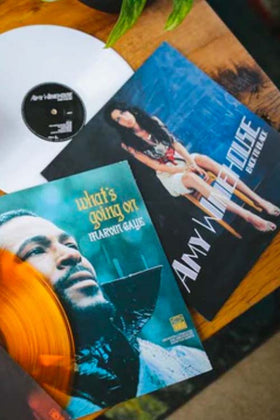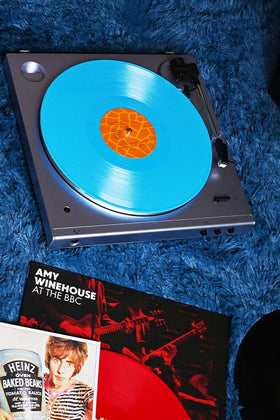How to Store Vinyl Records?
How to Store Vinyl Records?
The way you store your vinyl records can have a drastic impact on the longevity of your albums. If you’ve ever purchased records from a garage or yard sale that have been sitting in an attic for decades, you know exactly what we mean.
Vinyl is a delicate medium, and it is really easy to damage if you don’t know how to properly store it. The environment, temperature, humidity, and other factors all contribute to the health and condition of your LPs.
We’re going to tell you everything you need to know about vinyl storage, including where to store records, how to store them, and all of the common mistakes and pitfalls you should look to avoid.
Where to Store Vinyl Records
The location you choose to keep your record collection is essential to maintaining your albums. Many people choose to chuck their old LPs in an attic or a shed, but this is not always the best choice. There are a few elements you need to consider when exploring storage options for your vinyl records.
Temperature
The first and most important aspect to consider is the room temperature of the area. You want to store vinyl records in a cool place—not too cold, but not too hot. If the vinyl is exposed to high heat for extended periods of time, it can lead to warping and other damaging effects.
If you have a temperature-controlled attic or storage unit, that can be a great choice. However, most attics will get far hotter than the rest of the house. Cellars can be a great choice, but you need to pay close attention to the moisture level in that area.
Humidity
The second most important aspect to consider when it comes to storing your vinyl records is the humidity level. High humidity or moisture in the air can cause significant damage to your albums over time.
The Northeast Document Conservation Center recommends you store LPs at a temperature of around 50-60 degrees Fahrenheit and a humidity level of 30-40 percent.
In a normal home, a finished basement is usually ideal for this, as it will remain cooler without getting as humid as a cellar might. If that isn’t an option, just try to find a room in your house that will remain cool and typically have low humidity.
Light
This is something that many people don’t think about, but it is also important if you want to maintain your records in the best condition possible. Excessive exposure to bright lights and direct sunlight can, over time, damage your LPs. This is especially true with ultraviolet light.
This won’t be an issue in most cases, but if you have a large window next to your records or you have a plant-growing setup with UV lights, be careful not to store your records in view of the light.
How to Store Vinyl Records
Once you’ve chosen a location for storing your collection of albums, you’ll also need to determine how you’re going to store them. There are two types of storage for vinyl records—short-term and long-term storage.
Short-term vinyl record storage
For records that you actively listen to, you will want to use a short-term storage solution. You can keep these on a shelf under your turntable and pull them out as you use them. The temperature for these can push up closer to 70 degrees, but you’ll want to still make sure the humidity is not too high.
When in consistent use, you will not need to be as cautious with how you store them. That is, as long as you are cleaning them properly before and after each play and you do not have a large number of records sitting out on your shelf.
Here at The Sound of Vinyl, we sell inner and outer sleeves to help store and protect your records. Inner sleeves go between the vinyl and the cardboard cover. They are made of anti-static paper or plastic and help to keep dust from collecting on your vinyl.
Records will typically come with a paper sleeve, but the plastic ones are far superior. In fact, using paper sleeves can actually scratch your records over time. Avoid them if you’re able to and opt for plastic instead.
Outer sleeves are typically made from plastic and help to protect both the cardboard album cover and the vinyl inside. If you purchase old records, you are more likely to still have an inner sleeve than an outer sleeve, but both are helpful in protecting your LPs.
Long-term vinyl record storage
Unfortunately, most people do not know how to properly store their vinyl collections for the long-term. If they are not going to be touched for a year or more, you will want to find a more permanent place to store them.
There are a few things you’ll want to keep in mind when putting your records into storage, especially if you have a lot of them.
Pressure
The most common mistake people make when storing vinyl records is not considering the pressure that is placed on them. A 12-inch LP typically weighs more than 5 ounces. If you have 50 of these on a shelf, that’s between 15-20 pounds of pressure leaning on the last LP in line.
For a minute or two, that won’t be a problem. However, if you’re putting records away for an extended time, make sure there isn’t too much pressure weighing on any of the records. This can cause warping, groove distortion, and a host of other problems.
Shelving
Due to the pressure problem, you want to avoid throwing all of your records into a bin if possible. As time goes on, they will continue to fall and push on themselves, potentially causing long-term damage.
Instead, opt for some sort of shelving solution where you can keep sections of records separated. You don’t want to have more than about 15 records leaned on one another on a shelf, as more than that will lead to unwanted pressure.
In order to lessen the amount of static, you can go with a wood shelf as opposed to a metal one. This will help to protect your records from static electricity and dust buildup.
Dividers
If you are unable to have a lot of shelves to separate your records with, make sure you have some strong, sturdy dividers. These are not hard to find online. You just need some thick wood to place between your records to help support them.
Ideally, LPs should stand up straight on the shelf instead of leaning to one side. This will help to lessen the pressure placed on the end records. You can accomplish this by placing a divider every 4-6 inches.
Moreover, you can use these to help organize your collection. Label each divider by genre or use them to place your records in alphabetical order. This is a great option that takes care of two issues at once.
If you want to give it a shot, Vinyl Me Please has a great DIY guide for creating your own record dividers. This may not be for everyone, but it can save you some money and be a ton of fun in the process.
Cleaning
One last note on long-term storage, be sure to thoroughly clean them before placing them in storage. The Sound of Vinyl has an extensive guide on record cleaning, including how to deep clean old, beat-up records.
If they are new records, be sure to brush them down with an anti-static brush to remove any dust or debris in the grooves. If that sits over time, it can work its way too deep into the record to be removed, and the next time you play it, the stylus will embed that dust into the LP. This is what leads to a lot of crackling and skipping when playing the LP back.
If the record isn’t in great shape, you’ll want to give it more of a deep clean. See our guide for detailed instructions on this.
Common Mistakes When Storing Vinyl Records
We mentioned a few of these earlier, but there are some common issues that we see when people try storing their collections. Here is a brief summary of things to avoid:
- Attic storage: If they are not temperature controlled, attics typically get far too hot for long-term vinyl record storage.
- Cellar storage: Basements and cellars are usually the right temperatures, but in many homes, they will be too humid to store a record.
- Too much pressure: Keep your records separated with dividers. Too much pressure leads to warping and other issues
- No sleeves: Inner and outer sleeves are essential to keeping your vinyl dust-free. If static electricity builds up on the vinyl, it attracts dust like a magnet
- Weak shelving: Vinyl is heavy. If you don’t have a sturdy shelf under your collection, the shelving could easily break under the weight of the records.
In conclusion—make sure that you’re keeping your records in a cool, dry place, free from bright lights. And make sure you don’t just stack them all on top of each other. As long as you follow these steps, you should have a healthy vinyl collection for years to come.
Sources-
https://www.nedcc.org/preservation101/session-6/6storage-and-handling-of-media-collections
https://magazine.vinylmeplease.com/magazine/diy-record-dividers/




